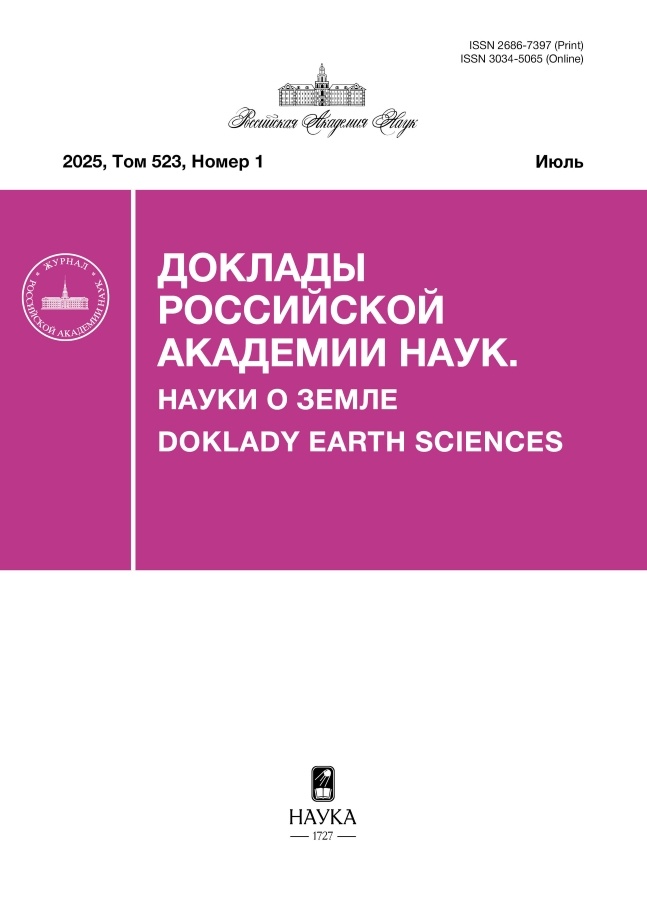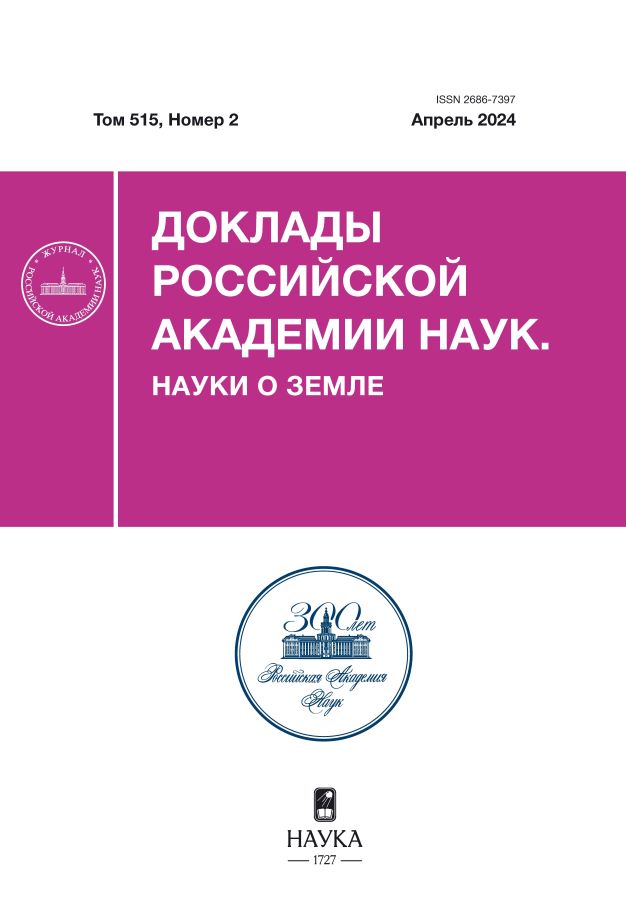Возраст, состав и петрогенетические механизмы формирования лейкогранитных интрузий Восточного Казахстана
- Авторы: Хромых С.В.1, Котлер П.Д.1, Крук Н.Н.1
-
Учреждения:
- Институт геологии и минералогии им. В. С. Соболева Сибирского отделения Российской Академии наук
- Выпуск: Том 515, № 2 (2024)
- Страницы: 237-244
- Раздел: ПЕТРОЛОГИЯ
- Статья получена: 31.01.2025
- Статья опубликована: 15.10.2024
- URL: https://vestnik.nvsu.ru/2686-7397/article/view/649946
- DOI: https://doi.org/10.31857/S2686739724040086
- ID: 649946
Цитировать
Полный текст
Аннотация
В пределах Восточного Казахстана проявлены несколько крупных интрузий, сложенных на 60– 90% лейкогранитами. Приведены сведения о возрасте этих интрузий, рассмотрены особенности вещественного состава пород, сделаны выводы о петрогенетических механизмах выплавления лейкогранитных магм. Установлено два этапа лейкогранитного интрузивного магматизма – в ранней перми и в раннем триасе, во внутриплитной геодинамической обстановке. Лейкогранитные магмы были образованы в результате частичного плавления коровых субстратов под воздействием базитовых магм. Геохимические различия лейкогранитов были обусловлены разным составом коровых субстратов и разными степенями их плавления.
Ключевые слова
Полный текст
Об авторах
С. В. Хромых
Институт геологии и минералогии им. В. С. Соболева Сибирского отделения Российской Академии наук
Автор, ответственный за переписку.
Email: serkhrom@igm.nsc.ru
Россия, Новосибирск
П. Д. Котлер
Институт геологии и минералогии им. В. С. Соболева Сибирского отделения Российской Академии наук
Email: serkhrom@igm.nsc.ru
Россия, Новосибирск
Н. Н. Крук
Институт геологии и минералогии им. В. С. Соболева Сибирского отделения Российской Академии наук
Email: serkhrom@igm.nsc.ru
член-корреспондент РАН
Россия, НовосибирскСписок литературы
- Guo Zh., Wilson M. The Himalayan leucogranites: Constraints on the nature of their crustal source region and geodynamic setting // Gondwana Research. 2012. V. 22. No. 2. P. 360–376.
- Владимиров А.Г., Крук Н.Н., Руднев С.Н., Хромых С.В. Геодинамика и гранитоидный магматизм коллизионных орогенов // Геология и геофизика. 2003. Т. 44. № 12. С. 1321–1338.
- Зоненшайн Л.П., Кузьмин М.И., Натапов Л.Ш. Тектоника литосферных плит территории СССР. М.: Недра, 1990. Т. 1. 327 С. Т. 2. 334 с.
- Щерба Г.Н., Дьячков Б.А., Стучевский Н.И., Нахтигаль Г.П., Антоненко А.Н., Любецкий В.Н. Большой Алтай (геология и металлогения) / Кн. 1. Геологическое строение. Алматы: Гылым, 1998. 304 с.
- Peccerillo A., Taylor S.R. Geochemistry of Eocene calc-alkaline volcanic rocks from the Kastamonu area, Northern Turkey // Contributions to Mineralogy and Petrology. 1976. V. 58. P. 63–81.
- Frost B.R., Barnes C.G., Collins W.J., Arculus R.J., Ellis D.J., Frost C.D. A geochemical classification for granitic rocks // Journal of Petrology. 2001. V. 42. P. 2033–2048.
- Frost D.R., Frost C.D. A geochemical classification for feldspathic igneous rocks // Journal of Petrology. 2008. V. 49. P. 1955–1969.
- Johannes W., Holtz F. Petrogenesis and Experimental Petrology of Granitic Rocks. Minerals and Rocks Series. Berlin: Springer-Verlag, 1996. V. 22. 335 p.
- Pearce J.A., Harris N.W., Tindle A.G. Trace element discrimination diagrams for the tectonic interpretation of granitic rocks // Journal of Petrology. 1984. V. 25. P. 956–983.
- Whalen J.B., Currie K.L., Chappell B.W. A-type granites: Geochemical characteristics, discrimination and petrogenesis // Contributions to Mineralogy and Petrology. 1987. V. 95. P. 407–419.
- Хромых С.В. Базитовый и сопряженный гранитоидный магматизм как отражение стадий развития Алтайской аккреционно-коллизионной системы (Восточный Казахстан) // Геология и геофизика. 2022. Т. 63. № 3. С. 330–355.
- Боpиcенко А.C., Cотников В.И., Изоx А.Э., Поляков Г.В., Оболенcкий А.А. Пеpмотpиаcовое оpуденение Азии и его связь c проявлением плюмового магматизма // Геология и геофизика. 2006. Т. 47. № 1. C. 166–182.
- Khromykh S.V., Kotler P.D., Izokh A.E., Kruk N.N. A review of Early Permian (300–270 Ma) magmatism in Eastern Kazakhstan and implications for plate tectonics and plume interplay // Geodynamics & Tectonophysics. 2019a. V. 10. No. 1. P. 79–99.
- Хромых С.В., Волосов А.С., Котлер П.Д., Семенова Д.В., Алексеев Д.В., Куликова А.В. Пояса базитовых даек Жарминской зоны Восточного Казахстана: геологическая позиция, состав, возраст и геодинамическое значение // Вестник Восточно-Казахстанского Государственного Технического Университета им. Д. Серикбаева. 2021. № 4. С. 15–32.
- Khromykh S.V., Vishnevskiy A.V., Kotler P.D., Antsife-rova T.N., Semenova D.V., Kulikova A.V. The Kalba batholith dyke swarms (Eastern Kazakhstan): Mafic magmas effect on granite formation // Lithos. 2022. V. 426–427. Art. No. 106801.
- Reichow M.K., Pringle M.S., Al’Mukhamedov A.I., Allen M.B., Andreichev V.L., Buslov M.M., Davies C.E., Fedoseev G.S., Fitton J.G., Inger S., Medvedev A. Ya., Mitchell C., Puchkov V.N., Safonova I. Yu., Scott R.A., Saunders A.D. The timing and extent of the eruption of the Siberian Traps large igneous province: Implications for the end-Permian environmental crisis // Earth and Planetary Science Letters. 2009. V. 277. P. 9–20.
- Khromykh S.V., Kotler P.D., Kulikova A.V., Semenova D.V., Minnebaev K.R., Gareev B.I., Batalin G.A., Antsiferova T.N., Il’icheva E.A., Volosov A.S. Early Triassic monzonite–granite series in Eastern Kazakhstan as a reflection of Siberian Large Igneous Province activity // Minerals. 2022. V. 12. No. 9. Art. No. 1101.
- Gao P., Zheng Y.F., Zhao Z.F. Experimental melts from crustal rocks: A lithochemical constraint on granite petrogenesis // Lithos. 2016. V. 266–267. P. 133–157.
- Ebadi A., Johannes W. Beginning of melting and composition of first melts in the system Qz-Ab-Or-H2O-CO2 // Contributions to Mineralogy and Petrology. 1991. V. 106. P. 286–295.
- Aranovich L.Y., Newton R.C., Manning C.E. Brine-assisted anatexis: Experimental melting in the system haplogranite–H2O–NaCl–KCl at deep-crustal conditions // Earth and Planetary Science Letters. 2013. V. 374. P. 111–120.
Дополнительные файлы















